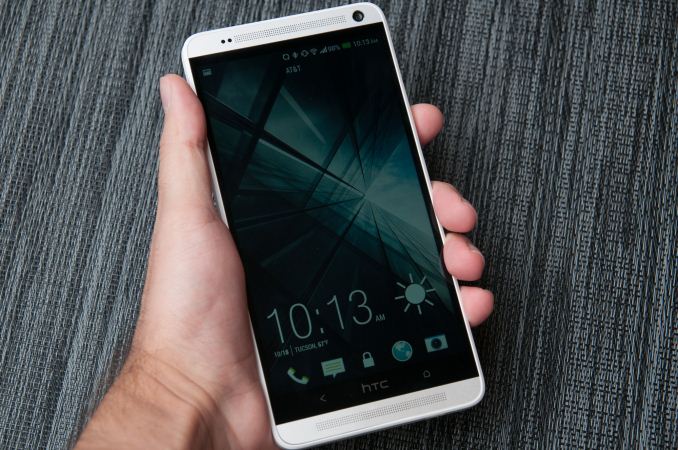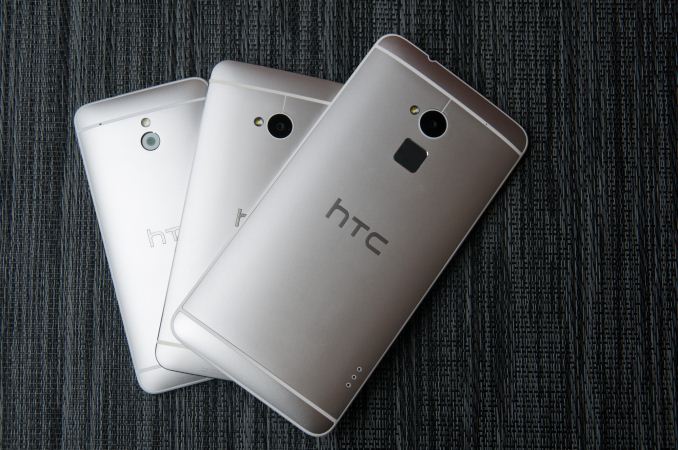HTC One max Review - It's Huge
by Brian Klug on October 28, 2013 10:00 AM EST- Posted in
- Smartphones
- HTC
- Mobile
- One
- Snapdragon 600
- Android 4.3
- One max
Concluding the One max review is difficult. I have a lot of conflicting thoughts about the larger sized smartphones and the state of that market, which seems to serve two purposes independently. For users who either don’t want or can’t budget for a tablet, the larger sized phones seem to bridge a functional gap between smartphone and tablet. Simultaneously, there are users who want the larger screen just to have it, and maybe there’s the perception that the larger phones still have some elevated status that comes with it. There’s a regional bias at play here too, and the One max seems to be a product designed to cater maybe more to some regions where supersized smartphones make up a bigger part of the market than others.
For me, the One max is probably a new upper bound in terms of size. It’s a very large phone, and although it fits in the front pockets of my jeans and shorts, it’s sometimes a stretch to sit down comfortably with the One max in a pocket. In terms of ergonomics, the One max is very much a dual-hand device.
The One max is really a product designed to fill out a hole in HTC’s One series portfolio than anything else, and doesn’t really change up the formula too much. It’s literally a scaled up version of the HTC One with few changes – OIS is unfortunately gone, the screen is obviously huge, there’s now a microSD card slot, and of course the new fingerprint sensor. Other than that though, the One max really is the One scaled up to gigantic size, with parts of the One mini tossed in for good measure.
I’ve said my part on the fingerprint sensor on the One max already. It works but isn’t the best or most intuitive implementation to date, although I think it’s fairly easy to make the case that nobody, not even Apple, has nailed a fingerprint sensor yet. The fingerprint scanner’s location on the back makes sense when you’re holding the One max in one hand, but becomes a problem when you’re using the phone on a flat surface. The use of a swipe sensor as well makes positioning on the back somewhat problematic unless you enroll fingers at a natural angle.
There’s also that elephant in the room about platform, specifically HTC’s inclusion of Snapdragon 600 APQ8064T instead of the faster Snapdragon 800 MSM8974 we’re seeing devices start shipping with right now. Although 8064 is still plenty fast and no slouch, there’s still a perceptible performance delta between an 8064 device and the newer 8974 phones I have on my desk now. I worry a lot about whether HTC will fall behind on platform, especially since it used to be the one OEM always shipping new Qualcomm silicon first. I have a feeling the One max saw platform change at the last minute, delaying its launch, but that's almost entirely speculation.
If you want a larger-screened smartphone and liked the One but have been waiting for a long time for the One max, by all means, get it. If you want a larger screened smartphone however, I think it’s easy to make the case that there are better devices out there right now. Had the One max arrived a month or two after the launch of the original One, this conclusion would've likely been a very different one.













197 Comments
View All Comments
Steven JW FCK - Monday, October 28, 2013 - link
How can you say a "very tiny part of the market" and know for certain? I know so many Samsung smartphone users, and do you want to know how many of them have been asked by Samsung how they use there micro SD cards, and the data storage facilities on their phones?NONE OF THEM!
So where on earth are you pretending to get your data from? And how exactly are you interpreting the numbers? I just fail to believe you actually know the ins and outs of phone storage and micro SD card usage in smartphones upon a broad enough scale to start making allegations like you have.
Believe the reality you want, it only exists in a very small and exceptionally annoying minority.
rabidkevin - Tuesday, October 29, 2013 - link
Bullshitsuperflex - Tuesday, October 29, 2013 - link
Agreed.Someone need to grease their gears. Their screech is annoying and not supported by a vast majority.
lazymangaka - Monday, October 28, 2013 - link
I don't understand the the reviewer's hatred of MicroSD cards. They're a useful thing to have, for every type of user. And, the fact of the matter is, internal storage space has not been rapidly increasing in smartphones. Storage needs have, however. Unlimited data plans are gone for many users, so listening to locally-stored music makes much more sense. In addition to that, the megapixel count of smartphone cameras continue to march north, and those larger file sizes are competing with ever-increasing app sizes. MicroSD expansion just makes sense.I understand what Google was trying to do in nixing external expansion in its Nexus lineup, but it just hasn't played out the way they wanted it to. Instead of getting a phone with 16GB of internal storage and an external expansion slot, we're more likely to just get a phone with 16GB of internal storage. Campaigning for the continued removal of MicroSD storage is doing nothing but harming us all.
Mondozai - Monday, October 28, 2013 - link
Lazumangaka:"I don't understand the the reviewer's hatred of MicroSD cards."
Every reviewer have their irrational foibles that makes no sense. You just have to learn those blindspots and avoid them like the plague with each particular reviewer.
With Brian we know he hates WP8, he dislikes microSD cards and he winces on AMOLED screens. He still puts out very qualified reviews but again, know when to listen, and when to just skip.
Brian Klug - Monday, October 28, 2013 - link
Luckily it's easy to back up the dislikes of microSD (poor Android support, slower than native storage, tradeoffs in build quality) and AMOLED screens (oversaturated, higher power drain, burn in, and sensitive to overheating), and reasons why I can't get anything done on WP8. They aren't blind spots that make no sense, they're just realities.-Brian
PC Perv - Tuesday, October 29, 2013 - link
What an arrogant hoax. You surely realize that every point you raise has counter points, right?How about being on consumer side for once? Make a case why 32 GB should be the bottom line. And why 64 GB should cost $20 more, not $100 more, etc,. Stop worrying about OEMs. They are doing fine. Think for once from consumers standpoint, instead of corporate-hired marketeering.
rabidkevin - Tuesday, October 29, 2013 - link
Hello apple paid spokepersonsuperflex - Tuesday, October 29, 2013 - link
Hello Samsung ShillDentons - Tuesday, October 29, 2013 - link
You're displaying confirmation bias, writ large.We can all find window dressing to support our opinions. That's why so many here object to your rants on AMOLED, microSD, and batteries. Despite your technical expertise, we realize your opinions in those areas has little basis in truth, and is largely just an smug opinion.
Yes, the NAND on many microSD cards is inferior to NAND built into devices. We know and we Don't Care! We use it to hold mass media, videos, photos, and music. What we care about far more is that microSD is often 10 times more cost effective and functions very well indeed.
Really Brian, telling users they really don't need the features they use and love is the height of contemptuous arrogance.